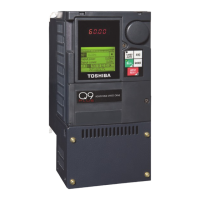Direct Access Parameter Information
Q9 Plus ASD Install/Op Manual
https://www.toshiba.com/tic/ 253
Note: NO/NC = Normally Opened/Normally Closed contact. NO/NC selection numbers are used when
making system changes via communications.
36 37 PID Off — Turns off PID control.
46 47 External Thermal Error — Causes an Over-Heat Trip (OH).
48 49
Serial/Local Switch (cancels serial priority) — Overrides any serial control and returns the
Command and Frequency control to the settings of F003 and F004.
50 51 Hold Direction (3-Wire Stop) — Decelerates the motor to a stop.
52 53 PID Differentiation/Integration Clear — Clears the PID value.
54 55
PID Forward/Reverse Switching — Toggles the gradient characteristic of the feedback
response of the V/I terminal during PID-controlled operation.
56 57 Forced Continuous Operation — Ignore PID control settings for the duration of activation.
58 59 Fire Speed — Runs Preset Speed 15 for the duration of the activation.
64 65
My Function Run Signal — Activates the configured My Function feature. See F977 for addi-
tional information on this parameter.
66 67
Autotuning Signal — Initiates the Autotune function. Set F400 to Autotuning by Input Termi-
nal Signal.
70 71 Servo Lock — Holds the motor at 0 Hz until a Run command is received.
74 75 kWH Meter Display Clear — Clears the kWH meter display.
76 77
Trace Back Trigger Signal — Initiates the data Read/Store function of the Trace Selection
parameter. See F740 for additional information on this feature.
80 81
Damper Feedback — Activation of this terminal indicates an open damper and enables the
system for normal operation. This terminal connects to a damper-mounted Damper Open/
Damper Closed switch.
86 87
Binary Data Write — Writes the status of the discrete input terminals to the control board
during binary input speed control.
88 89
UP/DOWN Frequency (up) — Increases the speed of the motor for the duration of activation
until reaching the Upper-Limit setting or increases the speed of the motor in steps. See F264
for additional information on this feature.
90 91
UP/DOWN Frequency (down) — Decreases the speed of the motor for the duration of activa-
tion until reaching the Lower-Limit setting or decreases the speed of the motor in steps. See
F264 for additional information on this feature.
92 93
UP/DOWN Frequency (clear) — While operating in the Up/Down Frequency speed control
mode this terminal initiates a 0 Hz output command. If operating with an activated UP/DOWN
Frequency (up or down) terminal, the output goes to the Lower-Limit (F013) setting.
94 95 Dancer Correction Off — Disables dancer correction.
98 99
Forward/Reverse — Operates in conjunction with another terminal being set to the Run/Stop
(100/101) function. When configured to Run (Run/Stop to CC), the activation/deactivation of
this terminal changes the direction of the motor.
100 101
Run/Stop Command — This terminal enables the motor to run when activated and disables
the motor when deactivated.
Table 9. Discrete Input Terminal Assignment Selections and Descriptions. (Cont)
Sel. No.
Terminal Selection Descriptions
NO NC

